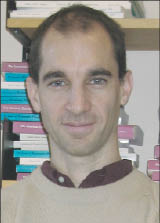 |
|
Oreopoulos: Report urges partnership between federal departments to ease aid applications. |
Testifying at his January confirmation hearing to become U.S. education secretary, Arne Duncan quipped that the federal student aid forms are so complicated that a person needs a Ph.D. to fill them out.
Actually, three people with Ph.D.s are working on a groundbreaking project that makes filling out the Free Application for Federal Student Aid, better known as the FAFSA, a 15-minute exercise – a project that researchers say could make college more accessible to low-income youths.
By tinkering with computer software that H&R Block uses for its tax services, the three researchers devised a way to capture information from IRS tax forms and automatically load it into the FAFSA, which requires much of the same information.
With the April 1 financial aid application and April 15 tax-filing deadlines looming, H&R Block recently expanded the FAFSA H&R Block Experiment, offering the service in 600 offices across the country, including in New York, Atlanta and Baltimore.
Experts on student aid say if the federal government adopted the same information-sharing methods – for which discussions are taking place – it would likely pave the way for greater access to college for many young people, especially low-income youths, who might otherwise be deterred by the formidable form.
“The goal is to determine whether such changes could help improve college access and persistence rates,” says a report by the researchers – Eric Bettinger and Bridget Terry Long, education professors at Stanford and Harvard universities, respectively, and University of Toronto economics professor Philip Oreopoulos. “This has implications well beyond education, such as increased income level and lower government dependency.”
“It should translate to more [FAFSA] applications and more successfully processed applications,” said Lauren Asher, vice president of the Institute for College Access and Success, based in Berkeley, Calif.
Asher is the author of a 2007 report, Going to the Source: A Practical Way to Simplify the FAFSA, that recommends, among other things, doing what the FAFSA H&R Block Project does: Use technology to streamline the FAFSA process by transferring information from tax forms. Asher noted in her report that the idea was not necessarily new then, but that advances in technology had made it more feasible.
How it Works
 |
|
Long: Report says findings “have implications well beyond education.” |
The project was launched in 2007 at 26 H&R Block offices in the Cleveland area, with funding from the Bill & Melinda Gates Foundation, the National Science Foundation, the Kauffman Foundation and the National Center of Postsecondary Research. Software was developed to flag families with incomes of less than $45,000 and with family members between ages 15 and 30 without college degrees. The families were paid $20 as an incentive to participate.
The families were placed into various groups, including a group that got help completing the FAFSA form from H&R Block and other groups that did not and received only basic information about the financial aid application process.
During the 2008 tax season, the project expanded throughout Ohio and into the Charlotte area of North Carolina, reaching about 26,000 tax-filers. The report says the participants’ average family income was $16,295, they had little or no savings, and they often relied on public assistance.
The project helped to alleviate such problems as low awareness of the FAFSA and misinformation about how much college costs, the report says. It says that among participants, almost half were familiar with FAFSA, but 26 percent had only heard of it without knowing many details, and 27.8 percent had not heard of it at all.
In addition, the report says, the project gave the families “accurate and early information about local tuition costs and eligibility for financial aid so they could have a realistic sense of the net prices they face.”
The project helped students meet the April 1 deadline to be eligible for additional state and institutional aid programs. Most H&R Block clients go in during February, well before that deadline.
It also addresses the problem of students not getting pertinent financial aid information until late in their senior year of high school. With tax specialists giving information about college costs and financial aid to families with students as young as 15, those families have years to plan to cover those costs.
The researchers wrote that they plan to measure outcomes, such as college aid applications, college enrollment and the attainment of postsecondary skills, but the program is too new to have accumulated data.
Expansion?
The report recommends “better communication” and “sharing information” between the U.S. Treasury Department and the U.S. Department of Education, so that not all of the FAFSA information has to be provided by the applicants. “Such a partnership could substantially reduce the time necessary to complete a financial aid application, as well as improve the accuracy of the information submitted,” the researchers wrote.
Asher, of the Institute for College Access and Success, said the project’s methods should be adopted by the federal government and offered for free.
A U.S. Education Department spokeswoman said such changes, including the workability of a universal system with the Treasury Department, are “under discussion.” That would help achieve one of the primary goals of the Higher Education and Opportunity Act of 2008, which calls for simplification of the process for filling out the FAFSA.
Although federal law prohibits H&R Block from profiting from its FAFSA assistance, the company said the service makes business sense. “The FAFSA process is a link in our relationship chain,” H&R Block spokesman Gene King said via e-mail. “By offering this service, H&R Block strengthens that client relationship.”
Resources: Going to the Source: A Practical Way to Simplify the FAFSA. http://www.ticas.org/wp-content/uploads/sites/13/pub/FAFSA_FINAL.pdf.
For a listing of H&R Block offices that offer FAFSA assistance, call (866) 908-9489.




























